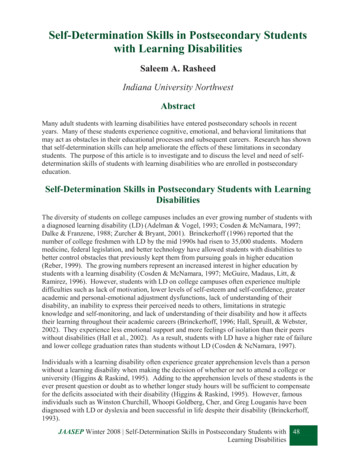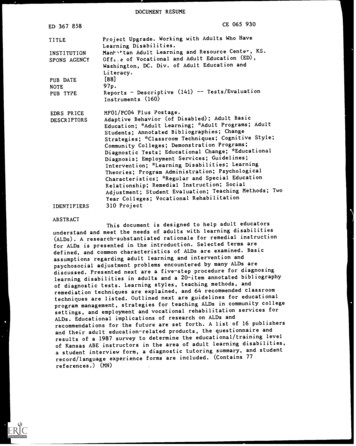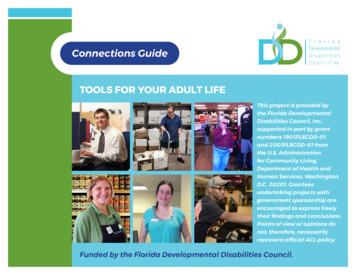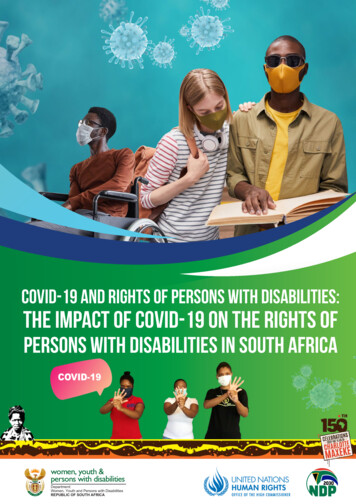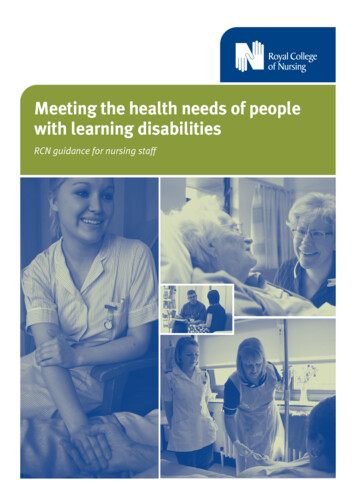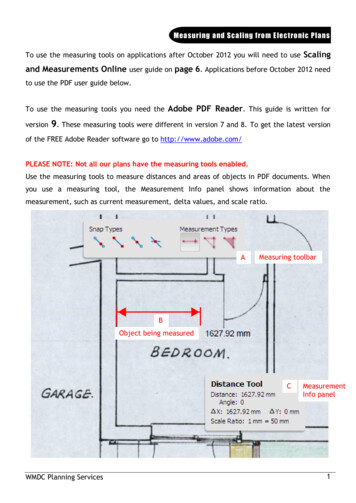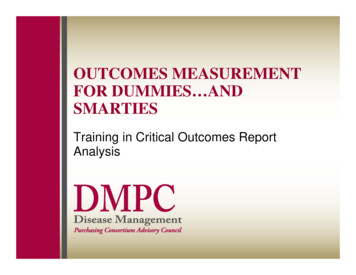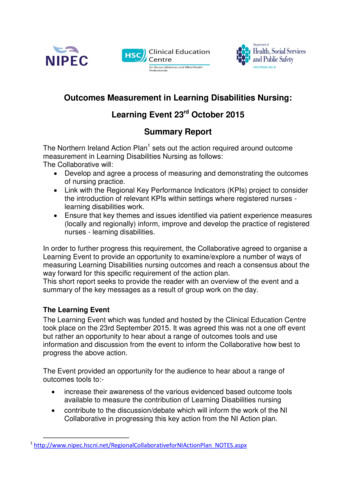
Transcription
Outcomes Measurement in Learning Disabilities Nursing:Learning Event 23rd October 2015Summary ReportThe Northern Ireland Action Plan1 sets out the action required around outcomemeasurement in Learning Disabilities Nursing as follows:The Collaborative will: Develop and agree a process of measuring and demonstrating the outcomesof nursing practice. Link with the Regional Key Performance Indicators (KPIs) project to considerthe introduction of relevant KPIs within settings where registered nurses learning disabilities work. Ensure that key themes and issues identified via patient experience measures(locally and regionally) inform, improve and develop the practice of registerednurses - learning disabilities.In order to further progress this requirement, the Collaborative agreed to organise aLearning Event to provide an opportunity to examine/explore a number of ways ofmeasuring Learning Disabilities nursing outcomes and reach a consensus about theway forward for this specific requirement of the action plan.This short report seeks to provide the reader with an overview of the event and asummary of the key messages as a result of group work on the day.The Learning EventThe Learning Event which was funded and hosted by the Clinical Education Centretook place on the 23rd September 2015. It was agreed this was not a one off eventbut rather an opportunity to hear about a range of outcomes tools and useinformation and discussion from the event to inform the Collaborative how best toprogress the above action.The Event provided an opportunity for the audience to hear about a range ofoutcomes tools to: 1increase their awareness of the various evidenced based outcome toolsavailable to measure the contribution of Learning Disabilities nursingcontribute to the discussion/debate which will inform the work of the NICollaborative in progressing this key action from the NI Action iveforNIActionPlan NOTES.aspx
Nominations were agreed locally by the Collaborative representative and a numberof other key stakeholders were specifically invited by the Chair of the Collaborative.The full to capacity audience comprised 71 participants from a range of keyorganisations. Ms Molly Kane, Nurse Consultant PHA chaired the day which wasopened by Dr Glynis Henry. A programme for the day can be viewed at Appendix 1.The morning session was specifically designed to include a number of speakers’covering a range of perspectives and outcomes tools used by nursing as follows: Care Planning and Patients Outcomes RQIA inspection findings RQIAperspective: W. McGregor, Mental Health & Learning Disabilities InspectorRQIANursing Objectives with Impact Professor O. Barr, Head of School UlsterUniversityUsing the Health Equalities Framework (HEF) in a uni-professional context.D. Atkinson, LD Nurse ConsultantLearning from the Pilot of the HEF in the BHSCT - Opportunities andChallenges Sister R. Brennan, BHSCTKey Performance Indicators (KPIs). Professor C. McArdle, Chief NursingOfficerSpecialist Intervention Specific outcomes tools. Dr. L. Taggart, Reader, UlsterUniversityOutcomes: are we hitting the target and missing the point? S. Rogan,Advanced Practitioner & Team Manager& Dr. H. Hanna Consultant Child &Adolescent Psychiatrist in Intellectual DisabilityOutcomes STAR, H.McCarroll, ASD Co-ordinator NHSCTGroup workThe afternoon session provided an opportunity for the audience to participate ingroup work to reflect on what they had heard during the morning session, offer theirperspective and to tease out practical aspects of outcomes measurement withinlearning disabilities nursing. At registration participants were randomly assigned to agroup. There were four work stations as follows:(1) Nursing Care Planning(2) Key Performance Indicators (KPIs).(3) Health Equalities Framework (HEF)(4) Moving ForwardEach group had the opportunity to contribute to each workstation using table matswhich posed a number of questions about the particular area/topic. The participantsfully engaged in all aspects of the day and the group work has yielded a rich sourceof information to help inform the Collaborative in how to progress this particularaction. Full transcripts of the notes of the feedback recorded via table mats can beprovided on request. Information gathered has been collated and the key messagesstemming from the analysis of the feedback is as follows:
Summary Findings(1) Nursing Care PlanningIt was reported that the use of nursing care plans varies across settings. It wasrecognised that user involvement in the nursing care planning process is not aswould be expected and care plans were not viewed as person centred as theyshould be. It was reported that opportunities for person centred focused objectiveslies with the Learning Disabilities Nurse completing them and there is a need to reinvigorate Learning Disabilities Nurses to develop and apply person centred nursingcare plans in practice.Challenges identified by the participants to improving the quality of care planningwere as follows: time, change management, culture, risk management i.e. whatpatient objectives are versus the professionals view.It was recognised that use of nursing care plans with the community is particularlydifficult. Over the last few years with the emergence of integrated care teams and theNorthern Ireland Single Assessment Tool (NISAT) Trusts have actively implementedMDT care plans. It was reported MDT care plans do not easily facilitate theextraction of nursing assessment, planning, intervention and evaluation. Participantsalso identified a need to challenge senior managers, to support the use of NursingCare Plans.Participants suggested that care plans should be more “user friendly” and personcentred although recognised that in some case this is difficult as care plans areelectronic which may not facilitate an easy to read approach.There was also a desire to ensure that realistic goals are identified as “discharge” isnot necessarily a realistic goal.Good practice example: SEHSCT have translated care plans into Easy Read andare therefore more accessible for service users.There was a general consensus that the Learning Event has been helpful inrefocusing Learning Disabilities Nurses in the importance of care plans indemonstrating outcomes and articulating the contribution of the Learning DisabilitiesNurse.It was reported that after today some participates suggested they would highlight andmake reference to care planning at team meetings. One table mat had the followingdocumented “Need change in culture and belief in what we do as LearningDisabilities Nurses”(2) Key Performance IndicatorsPotential indicators of good nursing practice included the following Health checks – reduction of health inequalities (x 4) Epilepsy management and epilepsy care plans Medication monitoring/compliance Assessment of mental health needs Assessment of nutritional needs Assessment of health assent (ie) BMI B/P
Evidence of Behaviour support plansParticipants reported that current KPI’s used in acute setting may be more relevantto Learning Disability in-patient settings or community based services. There was aview that KPIs should focus on the unique role of the Learning Disabilities Nurse andemphasise the Bio-psycho-social underpinnings of nursing and the role of theLearning Disabilities Nurse within that.There was a general consensus that KPI’s for Learning Disabilities Children’sservices would differ from Learning Disabilities Adult service or at least may have adifference emphasis. There was general agreement that there is no process in placeto measure or report KPI’s.As the discussion focused on Nursing KPIs there was limited discussion on MDTsKPIs as a result there was no consensus on what these might be.(3) HEFThere was a recognition that HSC Trusts/Organisations are using different outcometools within a range of services as demonstrated at the Learning Event. Generalfeedback that the HEF was very useful and particular reference was made to the factit had no upper age limit which was viewed as helpful. It was also felt its use will helpto protect the Learning Disabilities Nursing as a profession. Participants particularlyliked the “health and wellbeing” focus of the HEF.In terms of using it locally it was reiterated that there is a need for regional approachled by the DHSSPS to its introduction and implementation to ensure it becomesembedded. There is also recognition that application of the HEF at a regional levelwill require strong nursing leadership locally particularly as Learning DisabilitiesNurses work in MD teams. Colleagues made specific reference to the need fortraining and education for the Learning Disabilities Nursing workforce to support itsimplementation. There was some concern voiced as to how it can be used andintroduced as Learning Disabilities Nurses work in MD Teams.The HEF and Outcomes STAR particularly resonated with participants. TheOutcomes STAR was viewed as being particularly person centred and STAR can beused for different aspects of care. Those working in Children’s Learning Disabilitiesservices are awaiting HEF for children’s with anticipation.General consensus that one size does not fit all settings and therefore there needsto be a range of outcomes tools available to use. Outcome tools need to be personcentred and based on the needs of people with Learning Disabilities. General viewthat the outcomes tools currently used are dictated from “above” and this does notalways ensure the best outcomes for the patient.In terms of obstacles to the implementation of outcomes measurement tools thefollowing were identified under the headings of strategic, organisational andindividual StrategicLack of strategic visionNeed for training and support to implementTraining should be included on the Education Commissioning Group (ECG)plan- at regional level
OrganisationalOrganisations are too target driven and a sense they are gathering data thatis never usedOrganisations have purchased certain tools and therefore insist they must beusedDifficulty incorporating new tools /outcomes measures into existingdocumentation IndividualLearning Disabilities Nurses are already using a variety of toolsThe profession are still not well enough informed and require moreinformationWorking in MD Teams can be a challenge for Learning Disabilities Nurses inusing outcomes measurement tools specific to their roleOpportunities There are clear benefits in the use and application of outcomes tools as whenintegrated into care of each individual patient/client such tools facilitate themeasurement of change. “Outcomes tools should help shape personcentred care planning”. The HEF has specific “health focus” so thereforeviewed as positive for patients in reducing health inequalities.Next stepsRepeatedly there was an identified need for a regional approach to theimplementation of Outcomes Tools in Learning Disabilities nursing services. Anumber of participants suggested that education and training regarding nursingoutcomes tools should be covered in pre-post registration education.Conclusion There are clear benefits in the use and application of outcomes tools as whenintegrated into care of each individual patient/client such tools facilitate themeasurement of change. Potentially the use of Outcomes tools offers opportunity to help shape personcentred care planning and evidence the contribution of the LearningDisabilities Nurse. General consensus that one size does not fit all and therefore there shouldbe a range of outcomes tools available to use ranging from person centredcare plans to regional KPIs. (Development of a Framework) Outcome tools should be selected on their relevance to the needs ofpatients/clients with Learning Disabilities. There was an agreement for a regional approach to the implementation ofOutcomes tools in Learning Disabilities nursing services. There is recognition that working in MD Teams and the challenges ofextracting the nursing contribution to care from that environment can be abarrier for Learning Disabilities Nurses. Strong professional leadership and support at organisational and policy levelis required to ensure that Learning Disabilities Nurses are enabled to applyoutcome tools and KPIs which can facilitate the extraction of nursing input
Implementation of outcomes tool should be supported by relevant educationand trainingGeneral FeedbackFeedback and evaluation for the Learning event was extremely positive. 92% ofparticipants indicated that the event met their learning objectives, 90% indicated thatthe content of the event was applicable to their practice and 94 % indicated that thelearning Event was either Excellent, Very good or Good. Participants indicated that ifthe Collaborative was to arrange other Learning Events, they would be keen toattend.
Appendix 1ProgrammeOutcomes Measurement in Learning Disabilities Nursing: Learning Event23rd October 2015Venue: Lecture Theatre, Clinical Education Centre, Craigavon Area Hospital. BT63 5QQ.Time9.15-9.30TopicWelcome and introductionsSpeakerDr Glynis HenryTitleHead ofClinical Education Centre9.30 – 9.50Care Planning and PatientsOutcomesRQIA inspection findingsWendy McGregorMental Health &Learning DisabilitiesInspector, RQIA9.50 – 10.10Nursing Objectives with ImpactProfessor Owen BarrHead of School,Ulster University10.10 – 10.30Key Performance IndicatorsProfessor CharlotteMcArdleChief Nursing Officer10.30 -10.5010.50 – 11.10Tea/ CoffeeSpecialist outcome measurementtools11.10– 11.30Outcomes: are we hitting thetarget and missing the point?’Dr. Laurence TaggartSiobhan Rogan&Advanced Practitionerand Team Manager.Dr Heather HannaConsultant Child &Adolescent Psychiatristin Intellectual DisabilityASD Co-ordinator NHSCT11.30 – 11.50Outcome StarHeather McCarroll11.50 – 12.20Using the Health EqualitiesFramework (HEF) in auni-professional contextDave AtkinsonLearning from the Pilot of theHEF- Opportunities andChallengesRhona Brennan12.20-1.00Reader, Ulster UniversityIndependent NurseConsultant&1.00 – 1.45Panel discussionQuestion & Answer SessionLunch1.45- 3.10Café Style - Facilitated DiscussionWard Sister MuckamoreAbbey Hospital
3.10 – 3.45.3.45 – 4.00FeedbackSummary and closeDr Glynis HenryHead ofClinical Education Centre
MDT care plans. It was reported MDT care plans do not easily facilitate the extraction of nursing assessment, planning, intervention and evaluation. Participants also identified a need to challenge senior managers, to support the use of Nursing Care Plans. Participants suggested that care plans should be more "user friendly" and person
